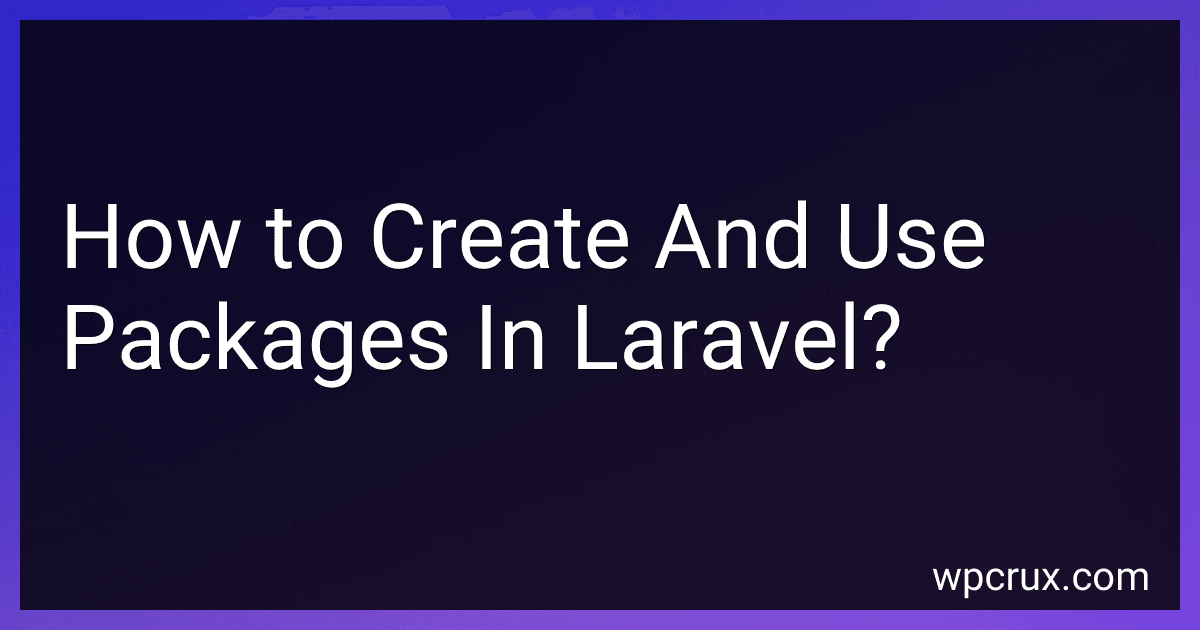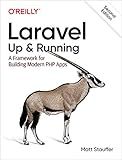Best Laravel Package Tools to Buy in October 2025
In Laravel, packages are an essential part of organizing and distributing reusable code. They allow you to encapsulate your code into self-contained modules, making it easy to share and maintain. Here is a brief guide on how to create and use packages in Laravel:
- Package Structure: Start by creating a new folder for your package in the "packages" directory of your Laravel application. Inside the package folder, create a sub-folder with the same name as your package. The basic structure should include directories like "src" for source code, "config" for configuration files, "resources" for views or assets, and so on.
- Package Service Provider: Create a service provider class under the "src" directory of your package. This class should extend the "Illuminate\Support\ServiceProvider" class. In the service provider, you can define any bootstrapping logic, register custom routes, views, migrations, or other components. Use the "register()" method to bind any services or dependencies your package requires.
- Package Configuration: If your package needs configuration options, you can publish a configuration file. Create a configuration file under the "config" directory of your package. In the service provider, use the "publishes()" method to make the configuration file publishable. This allows users of your package to customize the settings.
- Composer: Add your package as a dependency in the "composer.json" file of your Laravel application. Specify the package's source location using the "repositories" section if it is not available on Packagist. Run "composer update" to fetch the package and update the autoloader.
- Package Usage: After installing the package, Laravel will automatically detect the package's service provider. If required, you can manually register the provider in the "config/app.php" file of your Laravel application. Access the functionality provided by your package by calling its methods or using its classes within your application.
By following these steps, you can create and use packages in Laravel, making your code more modular, reusable, and easier to manage.
What is the difference between a shared package and a stand-alone package in Laravel?
In Laravel, a shared package refers to a package that is meant to be used across multiple projects or applications. It is typically installed globally on your system and can be used by any Laravel project by simply including it as a dependency in the project's composer.json file.
On the other hand, a stand-alone package in Laravel is a package that is specifically designed to be used within a single project or application. It is installed locally within the project's directory and is typically tailored to address specific requirements or functionalities of the project.
In summary, the main difference lies in the scope and installation method. Shared packages are installed globally and can be used across multiple projects, while stand-alone packages are installed locally and are specific to a single project.
How to define package routes in Laravel?
In Laravel, you can define package routes in a few simple steps:
- Create a new file for your package routes. By convention, this file is usually named routes.php and is located in the root directory of your package.
- In your routes.php file, you can use the Laravel routing methods like get(), post(), put(), patch(), and delete() to define your package routes. For example, you can define a route like this:
Route::get('/package-route', function () { return 'This is a package route'; });
- If your package requires a prefix or a namespace, you can use the group() method to define a route group. For example, you can define a route group like this:
Route::group(['prefix' => 'package', 'namespace' => 'Vendor\Package\Http\Controllers'], function () { // Package routes go here Route::get('/package-route', 'PackageController@index'); });
Note: Make sure to replace Vendor\Package\Http\Controllers with the actual namespace of your package's controller.
- If your package routes require authentication or any other middleware, you can use the middleware() method to apply middleware to the routes. For example, you can define a route with middleware like this:
Route::get('/package-route', 'PackageController@index')->middleware('auth');
- Finally, you need to include your package routes in the Laravel application's main routes/web.php or routes/api.php file. To do this, you can use the include() or require() function to include the package routes file. For example:
// routes/web.php include_once __DIR__.'/../vendor/vendor-name/package-name/routes.php';
That's it! Your package routes are now defined and can be accessed through the specified URLs.
How to install Laravel?
To install Laravel, follow the steps below:
- System Requirements: Make sure your system meets the minimum requirements for Laravel. Requirements include PHP, Composer, and additional extensions. You can check the specific requirements on the Laravel website (https://laravel.com/docs/8.x/installation#server-requirements).
- Install Composer: Laravel uses Composer for managing dependencies. Install Composer by following the installation instructions provided on the Composer website (https://getcomposer.org/doc/00-intro.md).
- Install Laravel: Open your terminal or command prompt and navigate to the directory where you want to install Laravel. Then, run the following command to create a new Laravel project: composer create-project --prefer-dist laravel/laravel project-name Replace project-name with the desired name for your project.
- Wait for Composer to download and install the Laravel dependencies. This process may take a few minutes.
- Configuration: Laravel will generate a .env file in the root of your project. Rename the .env.example file to .env and update the necessary configuration settings, such as database credentials.
- Generate Application Key: Run the following command to generate an application key for your Laravel project: php artisan key:generate
- Serve the Application: To run the Laravel application, you have multiple options. One way is to use the built-in development server by running the following command: php artisan serve This will start a development server at http://localhost:8000, allowing you to access your Laravel application in a web browser.
That's it! You have successfully installed Laravel on your system. You can now start building your Laravel application.
How to autoload classes in a Laravel package?
To autoload classes in a Laravel package, you can follow these steps:
- Namespace your classes: Ensure that all the classes in your package are properly namespaced. This is important to avoid any conflicts with other classes in Laravel.
- Add classes to composer.json: Open your package's composer.json file and add the necessary autoload information under the autoload section. For example, if your package's classes are located in the src directory and follow the MyPackage namespace, you can add the following autoloading information:
"autoload": { "psr-4": { "MyPackage\\": "src/" } },
- Run composer dump-autoload: After adding the autoloading information to your composer.json file, run the following command to regenerate the class autoloader:
composer dump-autoload
- Register your package's service provider: In your package's service provider, you need to define the autoloaded service provider. Open the register method in your package's service provider class and add the following line:
$this->app->register(MyPackage\ServiceProvider::class);
Make sure to replace MyPackage\ServiceProvider with the namespace of your actual service provider class.
- Install and test: Finally, install your package in a Laravel application using Composer. After installation, you should be able to use the autoloaded classes from your package in your Laravel application.
Note: It's important to remember that your package must be installed in the vendor directory of a Laravel application for autoloading to work correctly.
Following these steps will ensure that the classes in your Laravel package are automatically autoloaded when the package is installed in a Laravel application.



